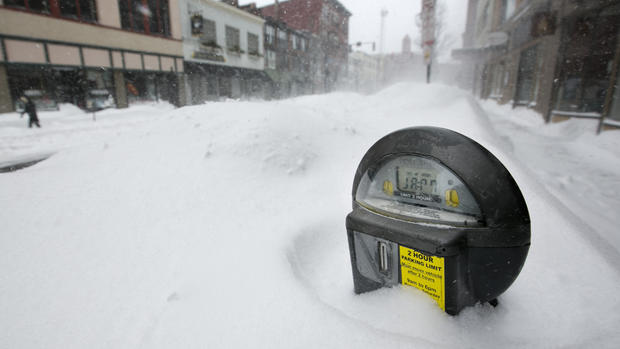Blizzard bears down on retailers, city governments
(MoneyWatch) The giant blizzard pounding the Northeast is expected to cost government, businesses and individuals a bundle, but estimating exactly how much is difficult because of the scale of the storm.
The storm's financial impact began even before the first flakes started to fall. Businesses and government offices from New York to Maine were closed Friday, and airlines have already cancelled more than 4,000 flights. Amtrak also shut down its train service early, as did mass transit systems across the region. Utility companies have called in thousands of repair crews from around the nation for post-storm repairs.
The National Weather Service is referring to the snowstorm as potentially "historic" in size, as two major storm systems converge in a pattern similar to what caused Hurricane Sandy. Boston, with a population of 625,000, is expected to be the hardest hit city. It is forecast to get at least 12 inches of snow, with some experts predicting two to three times that amount. The heavy snow could be accompanied by winds topping 60 miles per hour, which risks knocking out power to thousands of homes and business.
Although the blizzard is almost certain not to wreak the kind of damage caused by Sandy -- insurance company Munich Re Ag estimates total losses from the superstorm at $50 billion -- the snowstorm is likely to take a significant economic toll. The so-called "Storm of the Century" blizzard in March of 1993 caused U.S. retail sales to plunge 1 percent. In 1996, a January blizzard caused retail sales have their worst month of the year, with new car sales declining almost 6 percent.
- Northeast braces for massive winter wallop
- Airlines cancel more than 4,000 flights ahead of storm
- How to stay safe during the winter storm
One cost is relatively easy to estimate. The Massachusetts Department of Transportation projects that each inch of snow costs $1.2 million to remove, which is in line with the cost in other states. The blizzard of 2003 cost New York more than $20 million for snow removal alone.
Yet while affected retail stores are likely see a huge drop-off in sales during the storm and the ensuing clean-up, that is usually offset by the massive purchasing by consumers stocking up on supplies. Grocery stores and home suppliers like Home Depot (HD) and Lowe's (LOW) tend to do particularly well during such major weather events. In Massachusetts, there were also reports of long lines at gas stations, as well as of stations running out of all grades except premium.
Despite that temporary run on fuel, natural gas prices may decline next week. Half of the analysts surveyed by Bloomberg expect prices to drop because of above-normal temperatures forecast in the region for next week. While those temperatures may speed the recovery from the storm, they could also cause more damage as heavier melting snow may topple more trees and branches.
The storm will also have more isolated effects on business. Microsoft (MSFT), for instance, had been planning to launch its Surface Pro tablet computer with a big event on Friday at a Best Buy store in Manhattan. New York's Fashion Week, which started yesterday, could also take a hit from the blizzard. An average show at Lincoln Center can cost a designer anywhere from $50,000 to $200,000 dollars.
"Bad weather cancels shows," said Daniel Saynt of fashion blog Socialyte.com. "It leaves buyers unable to visit showrooms and has the potential to cost the industry millions in lost investments in staging events, hiring models and running fashion shows in spaces that are nearly empty, as all guests have decided to stay home."
Meanwhile, the blizzard will be a financial boon for some. The Northeast's beleaguered ski industry is hoping it will rescue what has been another slow season. Local ski resorts last year saw their worst year since 1991 because of the unusually mild winter. And this winter has so far been little better. Boston's Logan Airport has seen just 10.7 inches of snow this year, nearly 15 inches below average.

